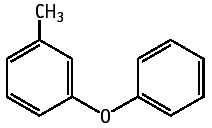

Decreased food consumption and increased water intake were observed in the 500 mg/kg group. Hematological examination revealed shortening of APTT in males given 500 mg/kg and decreased platelet counts in females given 100 and 500 mg/kg. Blood chemical examination revealed increases in albumin, the A/G ratio, ALP and urea nitrogen and decreases in total cholesterol, triglyceride, inorganic phosphate and glucose in the 500 mg/kg group. Increased urine volumes were evident in the 500 mg/kg group. The liver weights were increased and histopathologically, hypertrophy of centrilobular hepatocytes was noted in the 500 mg/kg group.
The NOELs for the repeat dose toxicity are considered to be 100 mg/kg/day for males and 20 mg/kg/day for females.
3-Phenoxytoluene was not mutagenic in Salmonella typhimurium, TA100, TA1535, TA98, TA1537 and Escherichia coli WP2uvrA. Regardless of the presence or absence of exogenous metabolic activation system, this chemical substance did not induce structural chromosomal aberrations in CHL/IU cells. Polyploidy was not induced under the conditions of the present study.
| Purity | : | 99.0% |
| Test species/strain | : | Rat/Crj:CD (SD) |
| Test method | : | Guidelines for 28-Day Repeat Dose Toxicity Testing for Chemicals (Japan) |
| Route | : | Oral (gavage) |
| Dosage | : | 0 (vehicle), 4, 20, 100, 500 mg/kg/day |
| Number of animals | : | Males, 6; females, 6/group |
| Vehicle | : | 0.1% Tween 80 solution |
| Administration period | : | Males and females, 28 days |
| Terminal kill | : | Days 29 or 43 |
| GLP | : | Yes |
Test results:
The NOELs for the repeat dose toxicity are considered to be 100 mg/kg/day for males and 20 mg/kg/day for females.
| Purity | : | 99.0 % |
| Test species/strain | : | Salmonella typhimurium, TA100, TA1535, TA98, TA1537, Escherichia coli WP2 uvrA |
| Test method | : | OECD Guidelines No. 471, 472 and Guidelines for Screening Mutagenicity Testing of Chemicals (Japan) |
| Procedures | : | Pre-incubation method |
| Solvent | : | DMSO |
| Positive controls | : | -S9 mix, AF-2 (TA100, TA98), Sodium azide (TA1535), ENNG (WP2 uvrA) and 9-Aminoacridine (TA1537) +S9 mix, 2-Aminoanthracene (all strains) |
| Doses | : | -S9 mix; 1.22, 2.44, 4.88, 9.77, 19.5, 39.1, 78.1 μg/plate (Salmonella strains) 313, 625, 1250, 2500, 5000 μg/plate (WP2 uvrA) +S9 mix; 4.88, 9.77, 19.5, 39.1, 78.1, 156, 313 μg/plate (Salmonella strains) 39.1, 78.1, 156, 313, 625, 1250, 2500 μg/plate (WP2 uvrA) |
| S-9 | : | Rat liver, induced with phenobarbital and 5,6-benzoflavone |
| Plate/test | : | 3 |
| Number of replicates | : | 2 |
| GLP | : | Yes |
Test results:
Genotoxic effects:
S. typhimurium, TA100, TA1535, TA98, TA1537
| + | ? | - | |
| Without metabolic activation: | [ ] | [ ] | [*] |
| With metabolic activation: | [ ] | [ ] | [*] |
E. coli WP2 uvrA
| + | ? | - | |
| Without metabolic activation: | [ ] | [ ] | [*] |
| With metabolic activation: | [ ] | [ ] | [*] |
| Purity | : | 99.0 % |
| Type of cell used | : | Chinese hamster lung CHL/IU cells |
| Test method | : | OECD Guidelines No. 473 and Guidelines for Screening Mutagenicity Testing of Chemicals (Japan) |
| Solvent | : | Dimethylsulfoxide |
| Positive controls | : | -S9 mix, Mitomycin C +S9 mix, Benzo[a]pyrene |
| Doses | : | -S9 mix (24 hr continuous treatment): 0, 50, 100, 200, 400 μg/ml -S9 mix (48 hr continuous treatment): 0, 25, 50, 100, 200 μg/ml -S9 mix (short-term treatment): 0, 50, 100, 200, 400 μg/ml +S9 mix (short-term treatment): 0, 25, 50, 100, 200 μg/ml |
| S-9 | : | Rat liver, induced with phenobarbital and 5,6-benzoflavone |
| Plate/test | : | 2 |
| GLP | : | Yes |
Test results :
| clastogenicity | polyploidy | |||||
| + | ? | - | + | ? | - | |
| Without metabolic activation: | [ ] | [ ] | [*] | [ ] | [ ] | [*] |
| With metabolic activation: | [ ] | [ ] | [*] | [ ] | [ ] | [*] |
| 1) | The tests were performed by the Mitsubishi Chemical Safety Institute Ltd., 14 Sunayama, Hasaki-machi, Kashima-gun, Ibaraki, 314-02, Japan. Tel +81-479-46-2871 Fax +81-479-46-2874 |